I've tested just about every AI writing tool out there in the last few years. And while they all promise to turn you into an ultra productive—almost superhuman—writer, the reality is that most just spit out robotic copy that takes longer to fix than writing from scratch.
But that isn't the case for all of them. Some AI writing tools really can make you more productive and help you create content... as long as you know how to use them.
So, to save you the trial and error, I’ve rounded up my 7 favorite AI tools for content writing. These are the ones I actually use week after week because they make writing faster, smoother, and honestly, a lot more fun.
Best AI content writing tools
Here are my top artificial intelligence picks for different users and use cases:
- Best overall: ChatGPT
- Best for natural, human-like writing: Claude
- Best for Google Workspace users: Gemini
- Best for writing search optimized content: Surfer
- Best for freelancers or content teams: Lex or Notion
- Best for scaling and workflow automation: Jasper
These choices come from years of testing in my job as a full-time content writer writing blog posts, as well as recommendations from friends and colleagues in the industry. I’ve tested all of them personally and regularly use them.
And this isn’t just a personal preference shift. According to Envato’s report on AI in Creative Work, nearly 50% of content professionals now use AI tools daily, with usage especially high among content creators and marketers.
Selecting the right AI writing tool isn’t just a nice-to-have anymore, it’s becoming an essential part of how modern content teams operate.
Let’s get to why these are my top AI tool picks, starting with the one that’s probably already sitting in your browser: ChatGPT.
1. ChatGPT
ChatGPT might seem like an obvious and boring choice, but hear me out.
While it’s not the best at everything, it’s probably the best all-rounder as it works well for pretty much every aspect of content writing, from research to drafting to editing.
Why I love it
It's the way these three features work together that makes it one of the best AI writing tools:
- Projects for organizing writing into workspaces with custom instructions.
- Custom GPTs for training versions of the model for specific writing tasks and target audiences.
- Canvas for "vibe writing" and real-time AI writing assistance and editing.
For example, if you write for multiple clients like I do, you can create a Project for each one with instructions for tone, editing guidelines, and so on to avoid blank page drama.

Note: Free users are limited to five files per project, while paid users get up to 25.
ChatGPT then refers to these for every edit, helping you keep your writing consistent even if you’re lazy with your edit requests (as I often am).

Editing itself is also super easy thanks to the Canvas, which is basically a live document where you can ask ChatGPT for edits on the fly.
For example, I didn’t like my original intro for this post, so I highlighted it in Canvas and asked ChatGPT to rewrite it using the PAS formula:
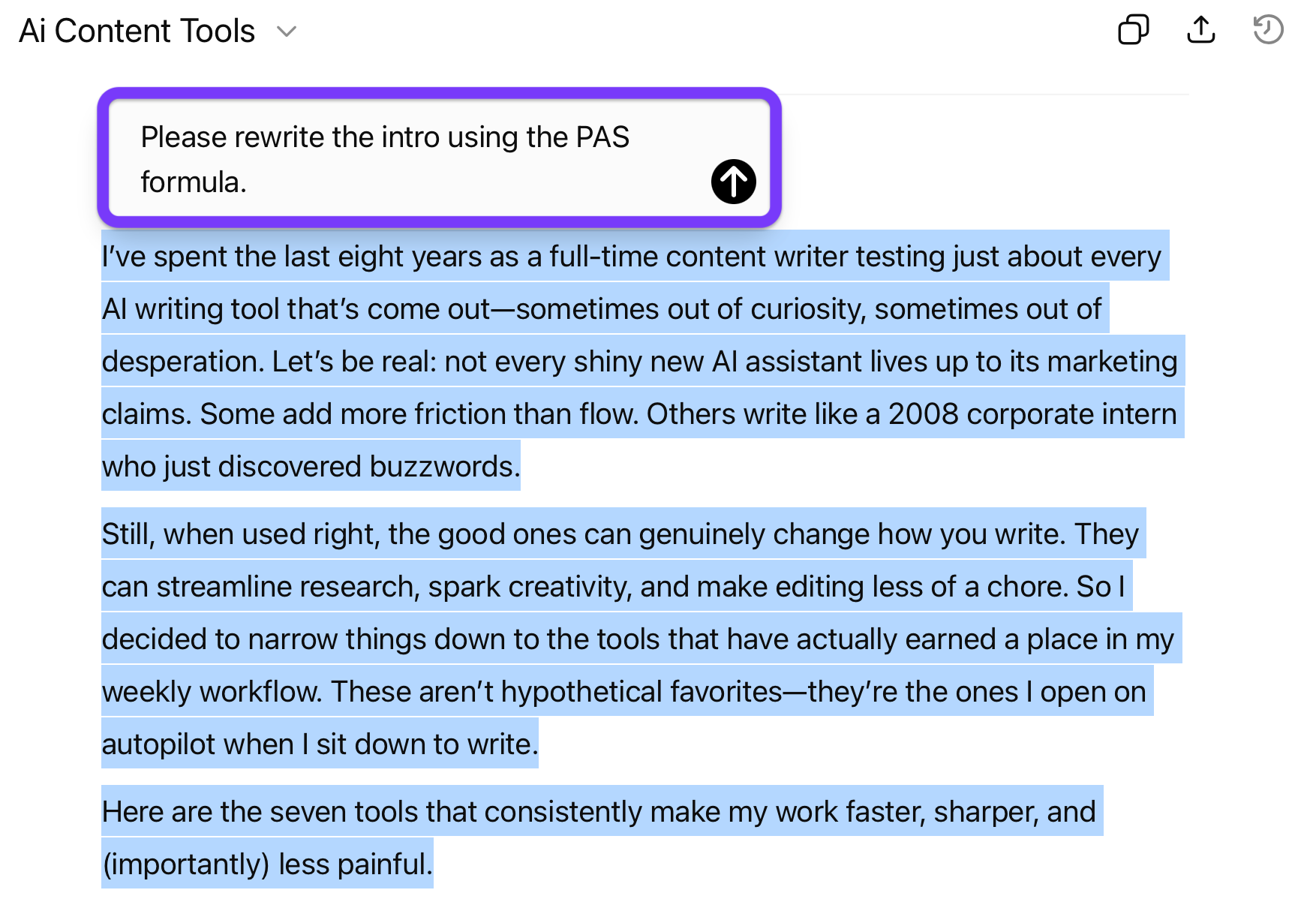
I also regularly use Canvas to have ChatGPT expand or clarify things:

For bigger edits, I turn to Custom GPTs trained for specific tasks.
Here’s one of mine, trained on Romana Kuts’ “Anti‑AI Phrasebook” to remove AI phrases:
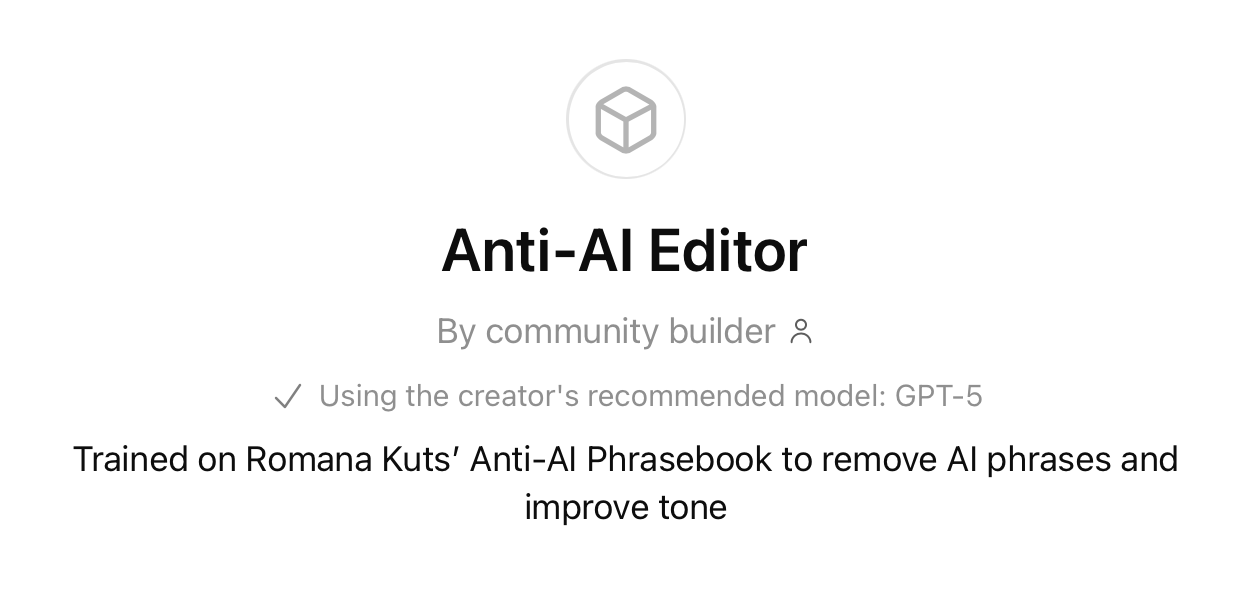
To call this, I just type @[custom GPT name] in Canvas, and it applies edits instantly:

More underrated perks: image generation and reading them.
I’ve used it to pull insights from screenshots and generate quick example social media captions—a small feature that saves a surprising amount of time.
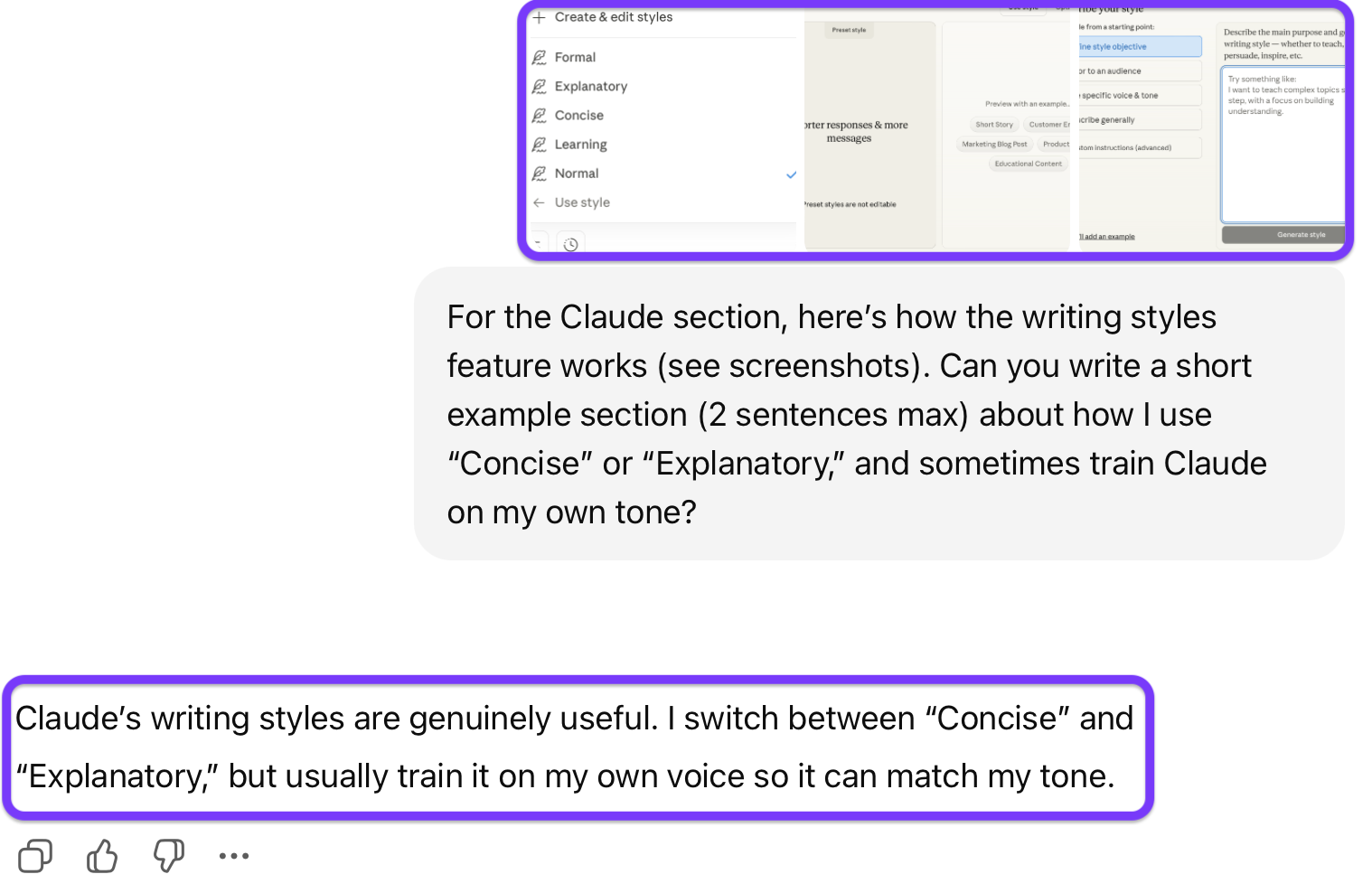
I’m really only scratching the surface of AI image generation and writing here, but hopefully, you can see how thoughtfully combining these features can seriously speed up and improve your content writing.
Pricing
Free plan available, so try this first and upgrade to Plus ($20/month—good enough for most people) or Pro ($200/month for a team plan) once you’re ready.
2. Claude
Claude caught me off guard in the best way.
I expected another slick but soulless AI content generator, but instead, I got something that actually feels human.
Its tone is natural, thoughtful, and just a little cheeky when you least expect it.
Why I love it
It’s the kind of AI writing assistant that makes your drafts sound like you’ve had a decent night’s sleep.
These are the parts that make Claude so easy to work with:
- Artifacts for drafting and formatting directly in chat.
- Projects for organizing your writing, files, and research.
- Writing styles for keeping tone consistent across clients.
The writing experience itself feels clean and minimal; it’s almost therapeutic.
Claude’s Artifacts (basically its version of Canvas) give you a live document view where edits happen in real time.
You can highlight text and ask for rewrites, but you can’t edit inside the Artifact yourself. That’s a small limitation compared to ChatGPT.

And if you need more information about something, the Explain function helps.

Then, when the draft’s ready, you can easily export it to Markdown and drop it straight into Google Docs or your CMS with the formatting intact.

As for its Projects feature, this mirrors ChatGPT’s setup:
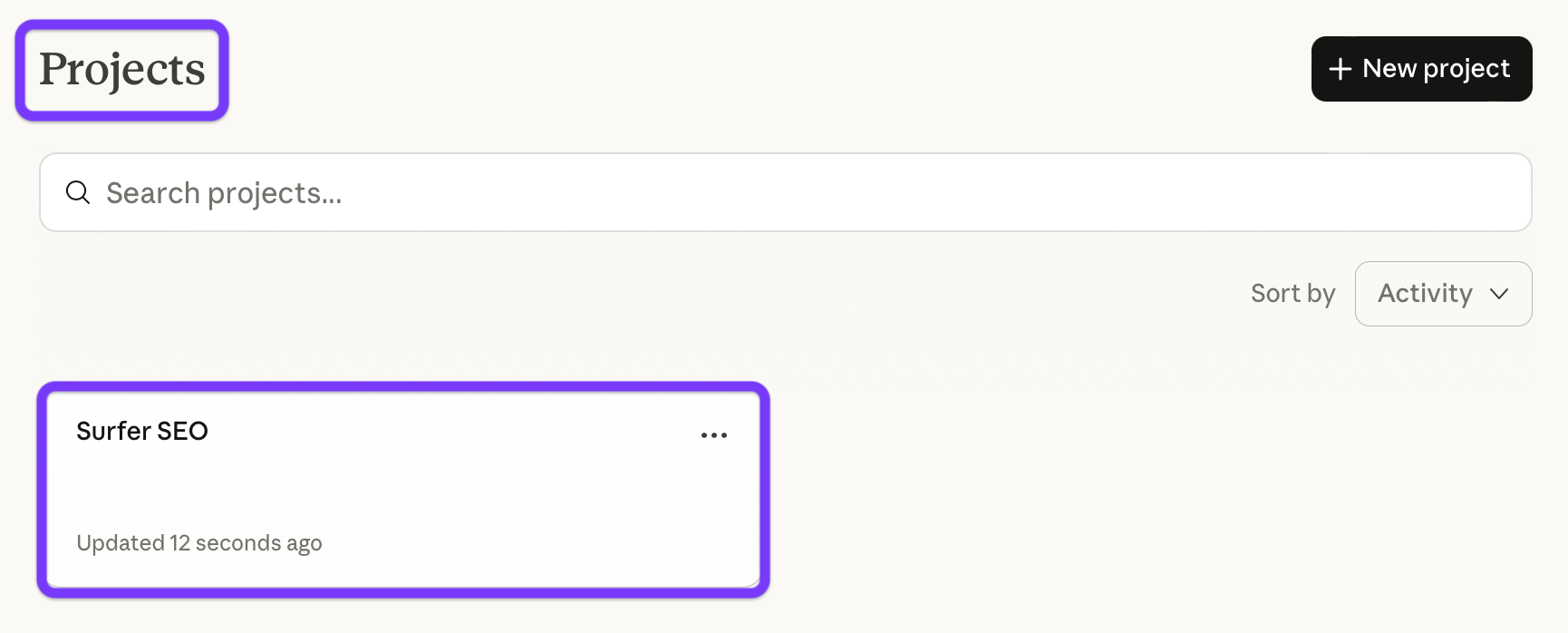
I keep outlines, client tone notes, and source docs here so Claude always knows what I’m working on.
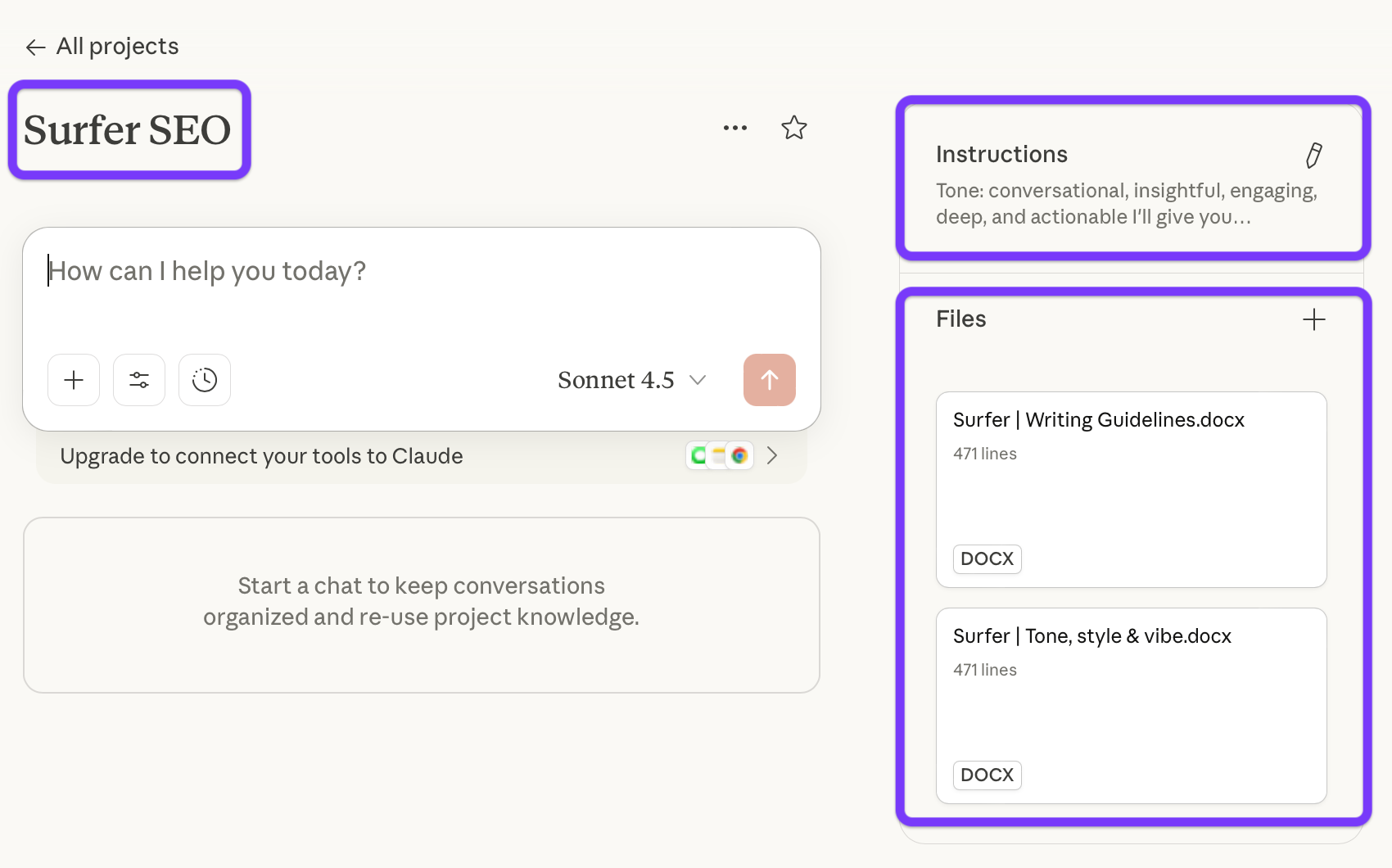
Note: Free version users can create one project, while paid plans unlock unlimited ones.
Claude’s writing styles are genuinely useful, even for social media posts.
I switch between “Concise” and “Explanatory,” but usually train it in my own voice so it can match my tone.
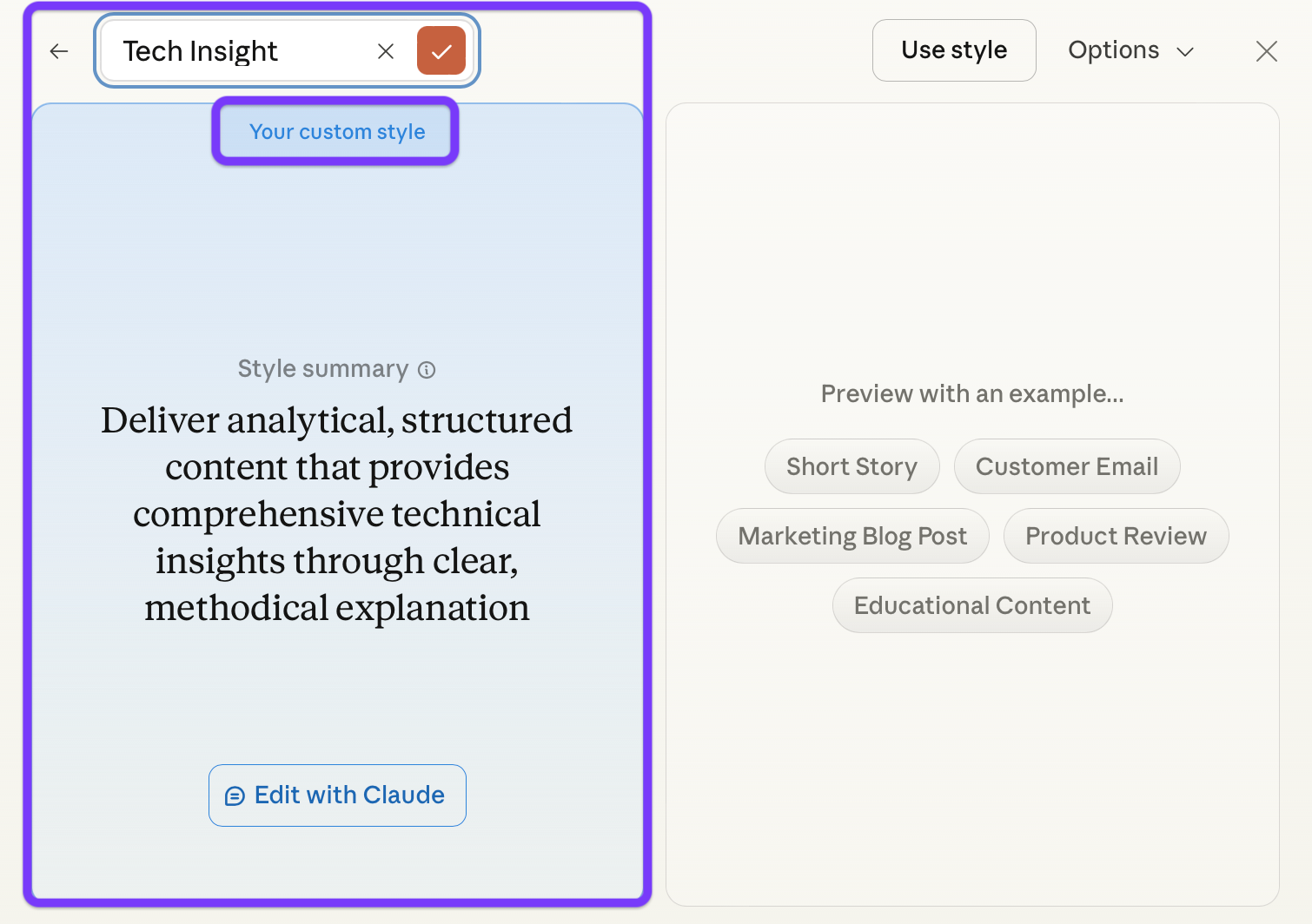
One of those small-but-smart extras: Claude’s connectors.
You can toggle web search or link PubMed for quick access to peer-reviewed research—perfect for anything data-heavy (I used it for a gut health piece recently).
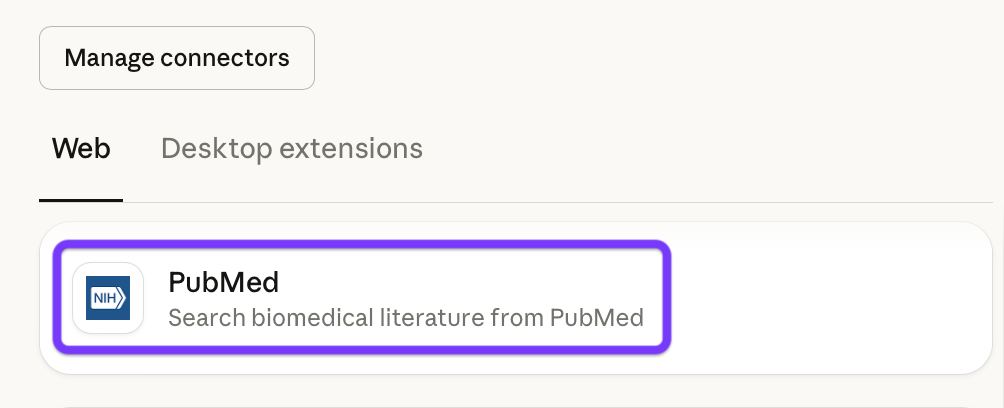
It’s not perfect. I wish I could type directly in the Artifact, but when I need writing that sounds human without needing hours of cleanup, Claude’s my go-to (even though ChatGPT is my ride-or-die).
Pricing
Free plan available. Pro starts at $20/month and Max from $100/month (both at monthly billing).
3. Gemini
If you live in Google Workspace (like I do), Gemini feels like the most seamless AI companion out there.
It’s integrated into Docs, Gmail, and Drive, so you can move from drafting AI-generated content to formatting and collaboration without leaving the ecosystem.
Why I love it
Gemini feels like the only AI tool that genuinely understands how writers work inside Google’s ecosystem.
These are the features that make Gemini feel like a true writing partner:
- Canvas for hands-on editing.
- Deep Research for SEO and topic briefs.
- Gems for personalized workflows.
Gemini’s Canvas is the standout for me.
Unlike Claude—where you have to ask the AI to make changes—Gemini lets you format, reorganize, and rewrite directly in the document.
It’s the first AI editor that feels like a real workspace, not just a chat box pretending to be one.

When I’m working on SEO-heavy pieces, I switch to Deep Research.
It scans top results, summarizes the trends, and gives me a full report—turning what used to be hours of SERP-hopping and a 27-tab research spiral into a five-minute read.
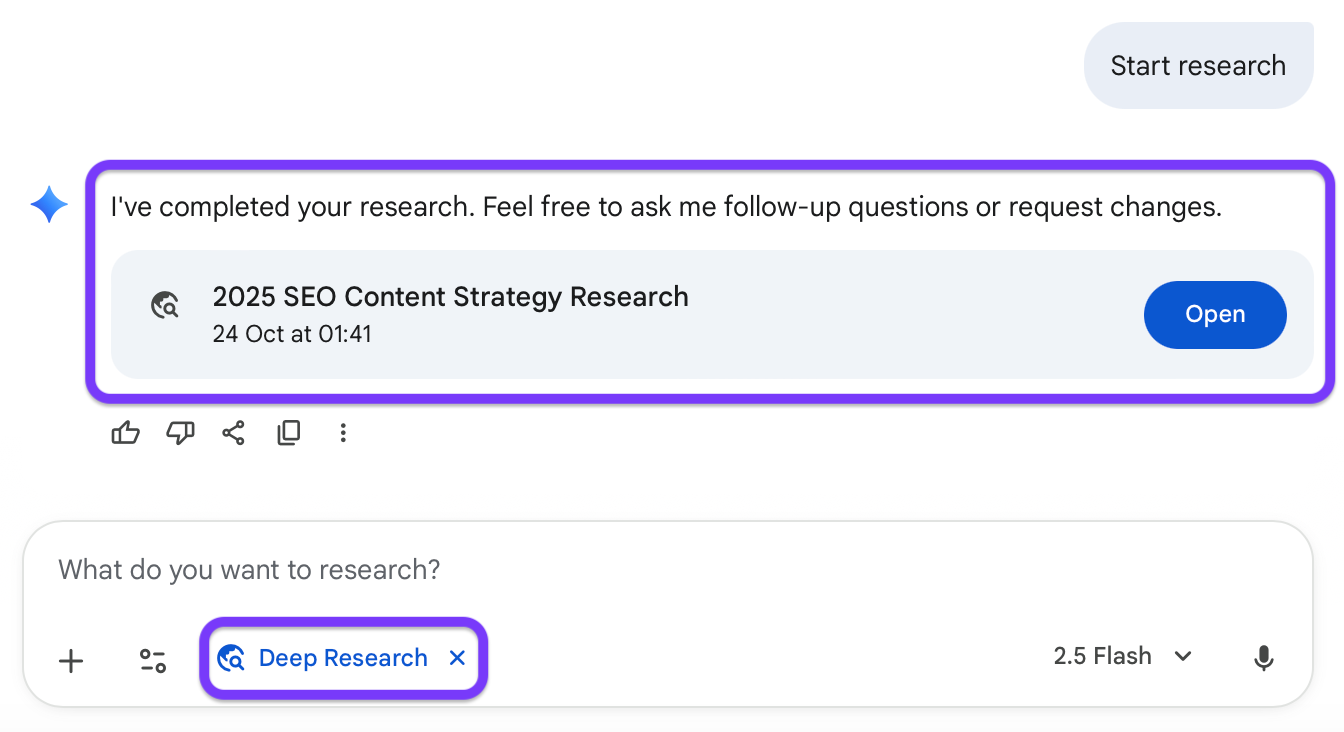
And for long-form projects, Gems and Instructions make life easier.
I use Gems like mini Custom GPTs. Each one remembers a client’s tone or structure guide, so I don’t have to retype it every time.
To use the Gem, I open it and type in the chat as I normally would when prompting.
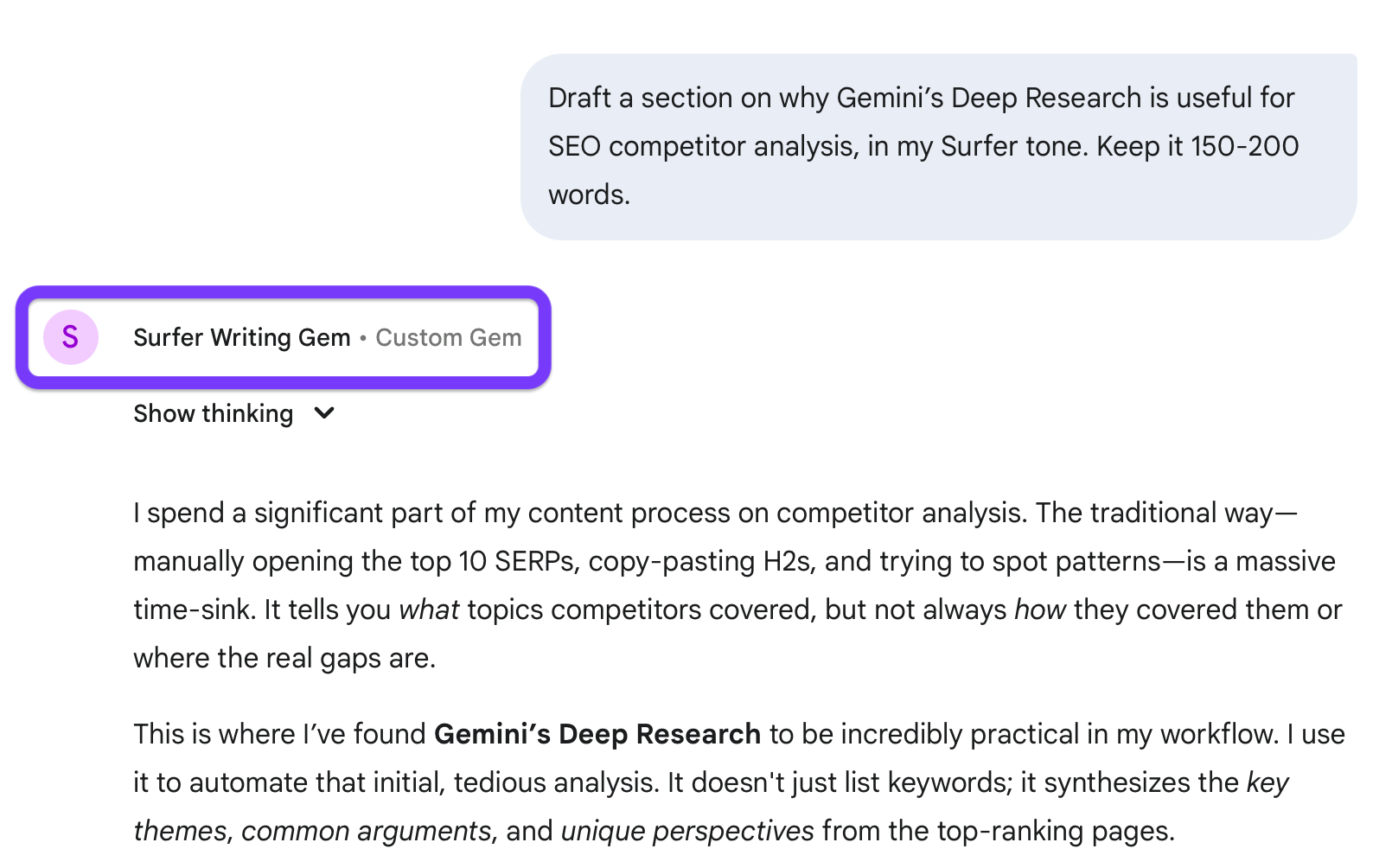
I also keep a few custom instructions—little reminders about tone and formatting—saved inside Gemini, so when I start a new draft, it already sounds like me.
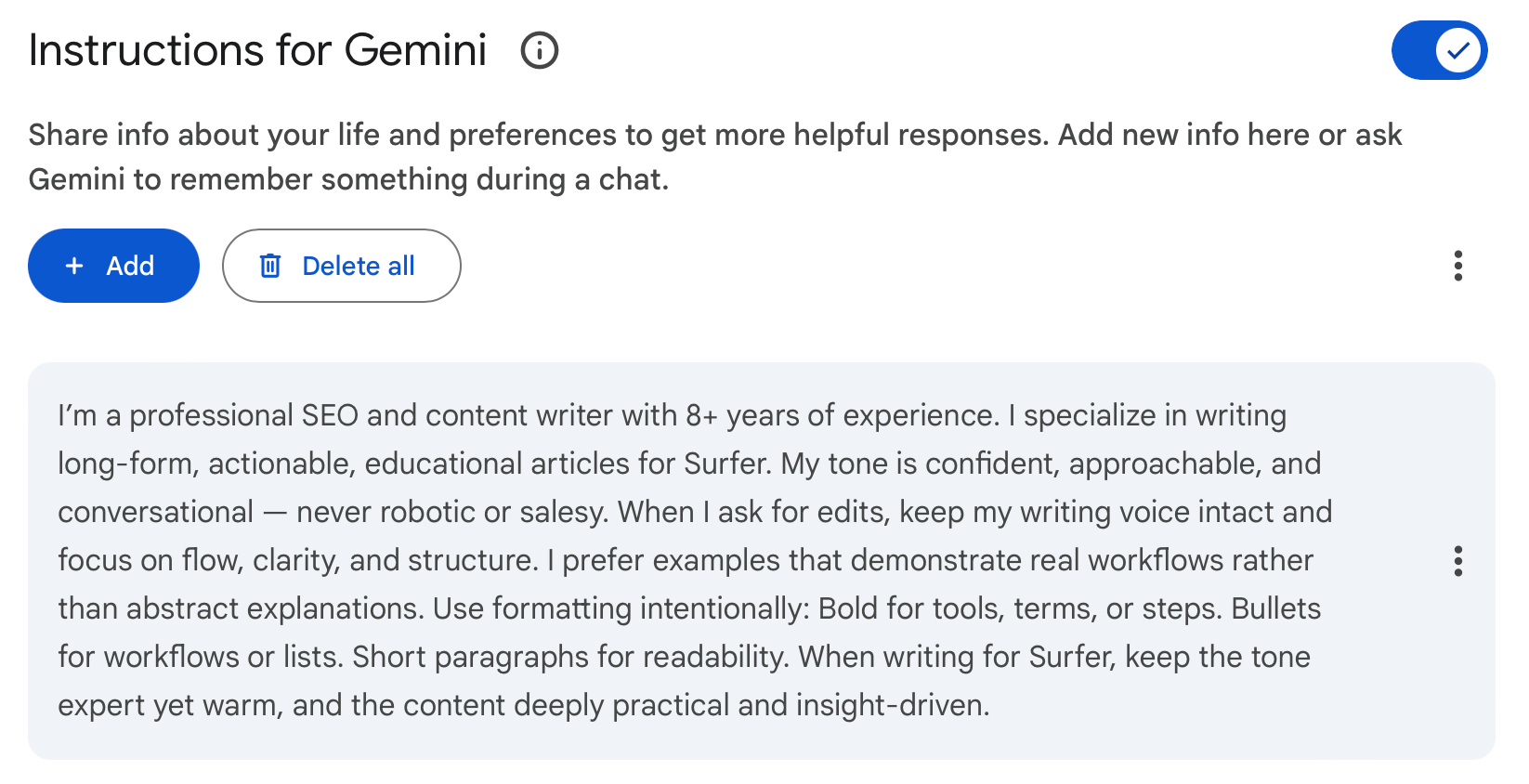
I saw Gael Breton (Authority Hacker) call Gemini’s Canvas ‘the most complete AI writing environment yet’—and I couldn’t agree more.

It’s the first time I’ve felt I could finish an entire draft without leaving the app—and honestly, I didn’t miss my usual chaos of 20+ open tabs.
Pricing
Gemini has a free student plan and a general one, with paid plans starting from $6/month for Pro and $20/month for Plus, which is the better option.
4. Surfer
I used to write for algorithms instead of people, buried in keyword spreadsheets and SEO guesswork.
Surfer changed that.
It helps me write for search intent, not just search engines, and shows what AI models actually surface.
Why I love it
Surfer takes the guesswork out of SEO writing. It feels like having an optimization coach sitting next to you, showing you what to add, cut, or reword in real time.
Here’s are the AI features that stand out most for me:
- Content Score for live SEO performance tracking.
- Auto-Optimize for instant NLP term enrichment.
- Surfy AI Assistant for in-editor rewrites and SEO tweaks.
The Content Score is my north star.
I used to overcomplicate SEO with a dozen tabs open—now I just watch my Content Score climb. It updates as I write, showing exactly how close my draft is to what’s already ranking.
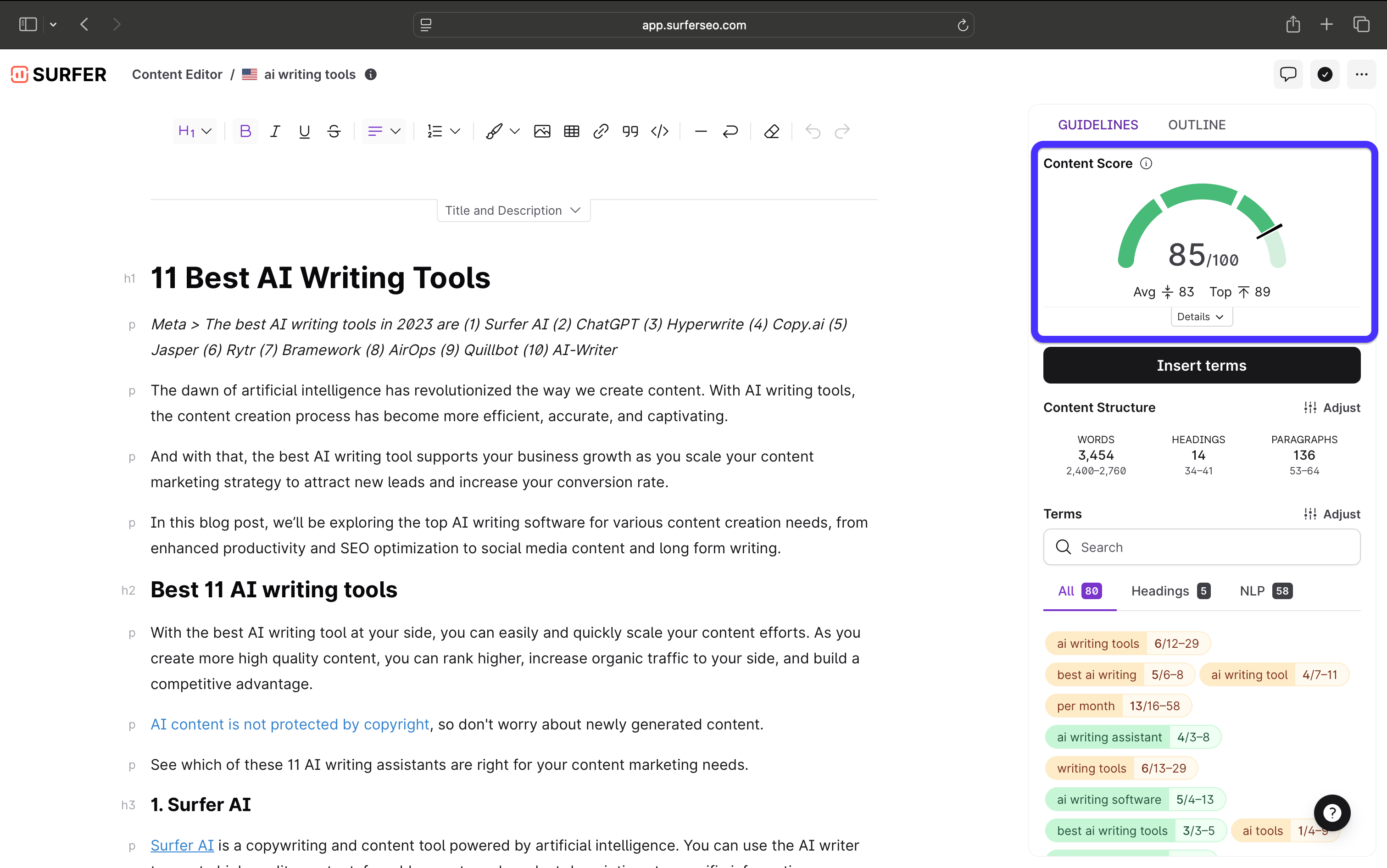
It’s surprisingly accurate too—Surfer’s data shows Content Score has a stronger correlation with rankings than backlinks.
When I’m tightening up an article, Auto-Optimize does the heavy lifting.
It analyzes my draft against the SERPs, adds missing keywords and context, and boosts the score instantly.
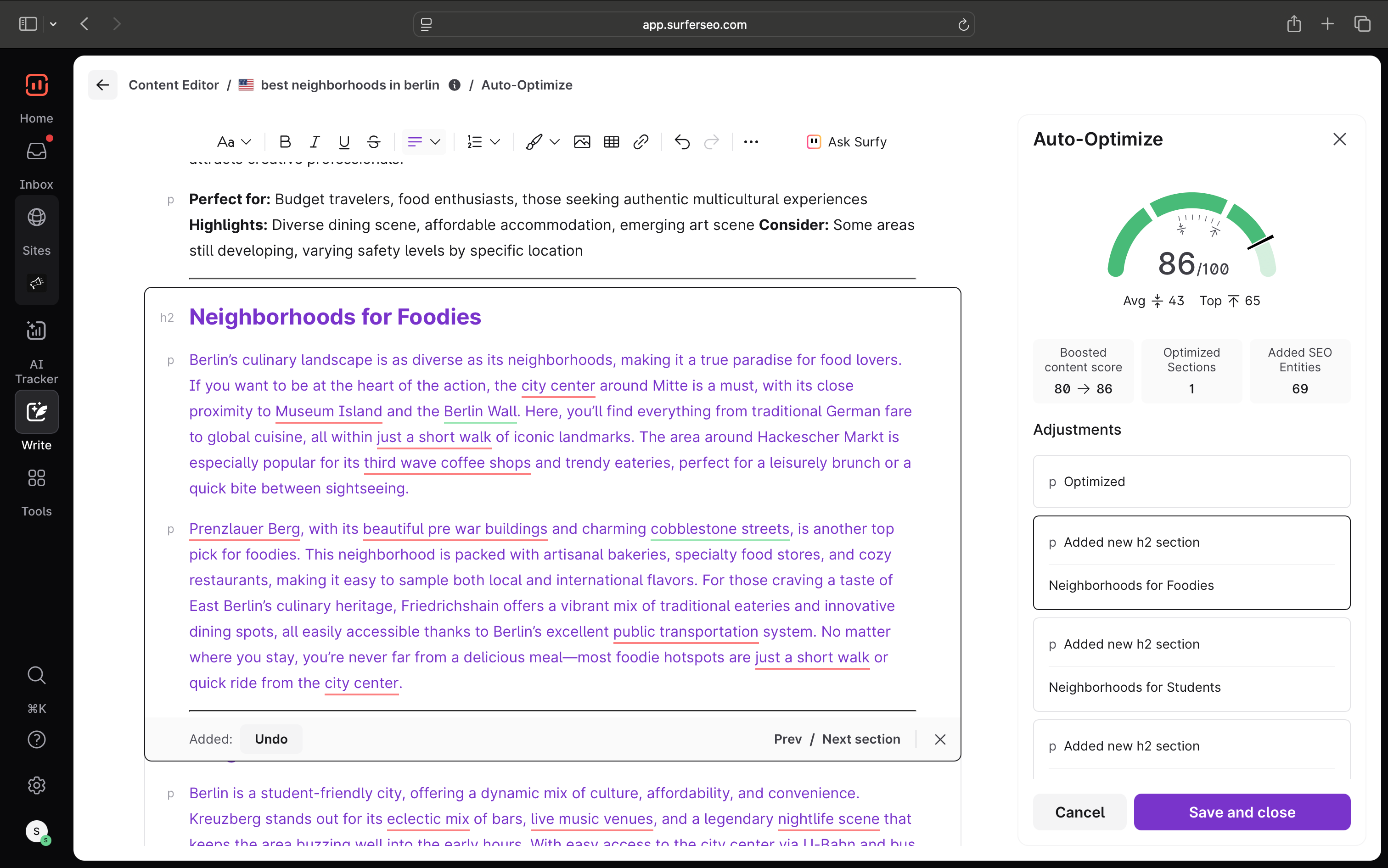
Then there’s Surfy, the built-in AI writing assistant.
I use it to rephrase clunky sentences, add examples, or back up claims with data—right inside the Content Editor.
Just highlight text and type “/AskSurfy.” It’s like ChatGPT for SEO writers, but smarter about context.

And when I’m done?
One click to auto-insert internal links and another to export to WordPress.
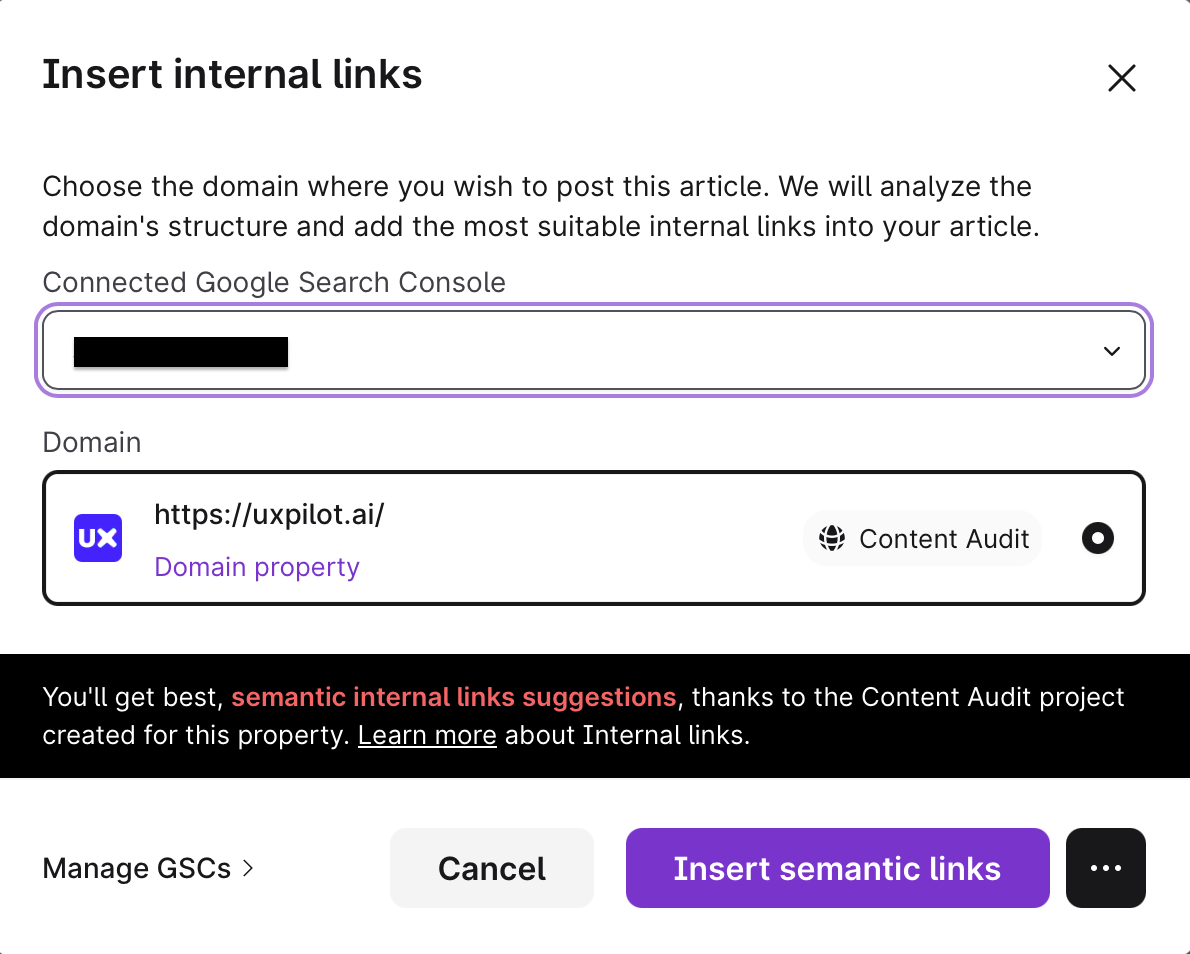
It’s the kind of end-to-end workflow that makes Surfer feel more like a production hub than a tool.
It’s everything I need to go from keyword to optimized article in one workspace, and that’s why it’s at the top of my personal AI-writing toolbox.
Pricing
The Essential plan starts at $79/month (annual billing), with Scale and Enterprise tiers unlocking AI visibility tracking, more credits, and collaboration tools to generate content.
There’s no free plan, but you get a 7-day money-back guarantee—enough time to see how much easier SEO writing can be.
5. Lex
I’ve tried more AI writing software than I can count, and most still feel like chatbots cosplaying as content creation tools.
Lex isn’t one of them. It was clearly built by someone who understands the writing process and stared down a few thousand drafts.
It’s clean, fast, and smart enough to help without getting in your way, whether you’re writing fiction or marketing copy.
Why I love it
Lex feels like Google Docs or Microsoft Word got a quiet AI upgrade. It’s smooth, minimal, and just makes sense. I write high-quality content instead of wrangling prompts (unless I want to).
What really sets it apart for me:
- Ask Lex for instant feedback, blog post outlines, rewrites, or brainstorming ideas.
- AI Checks for grammar, brevity, passive voice, and more.
- Multi-model access to switch between GPT-5, Claude, Gemini, and more.
Ask Lex is where I spend most of my time.
I simply highlight a line, click Ask Lex, and type what I need help with.

When I’m polishing a draft or ad copy, I run AI Checks for grammar and brevity.
Lex flags issues in pink, offers fixes, and explains why—like Grammarly, if it actually understood context.

If one model’s off-vibe, I just switch.
For example, if Claude is too poetic, I can switch to GPT5. If that’s too stiff, I can switch to Gemini. All of this happens mid-draft without having to switch tools.
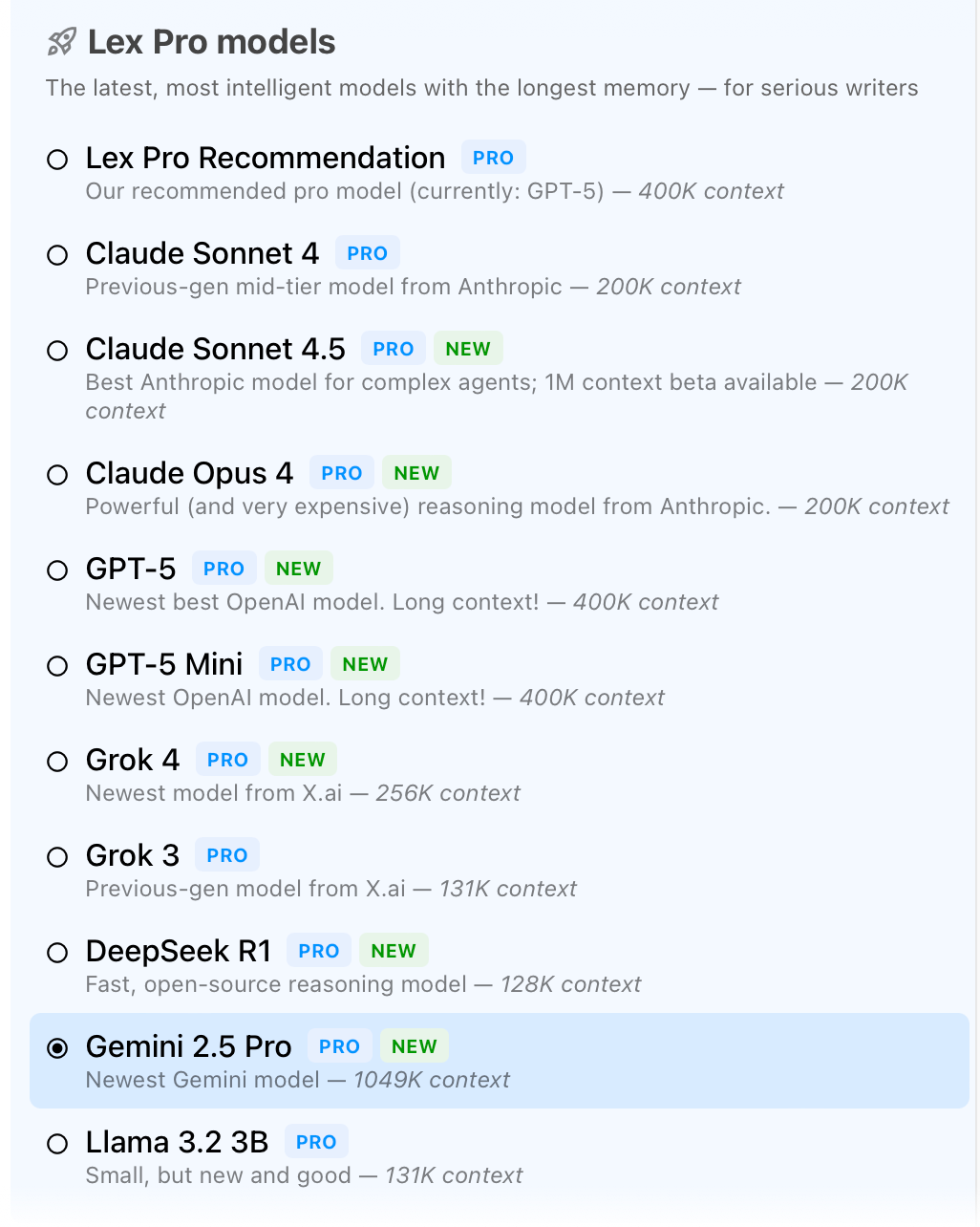
And if I need to tune out and just write, Focus Mode is my secret weapon…
It hides everything but the text and tracks word count and time—perfect for content writing or deep-focus sessions (and I have loads of those).
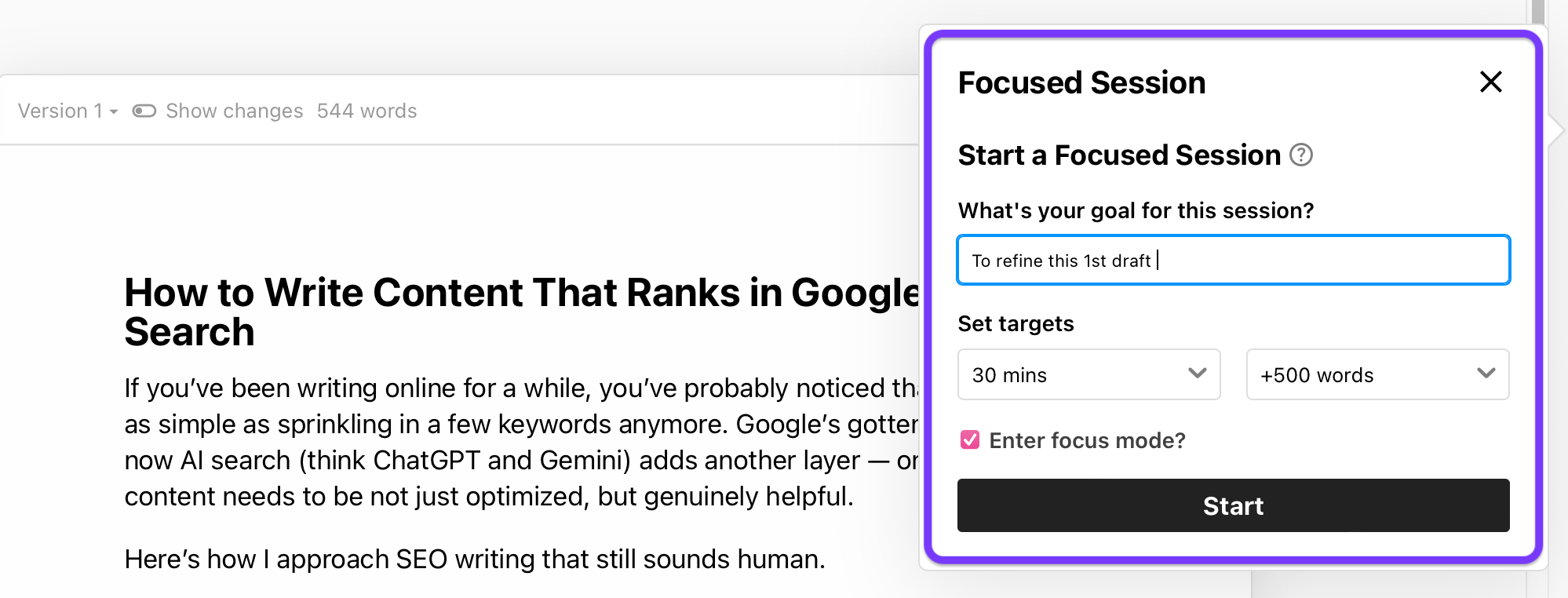
Then there’s Style Guides, which save so much setup time.
I trained mine on Surfer’s tone, so every edit already sounds on-brand. Upload samples once, and Lex remembers them across copywriting tasks.
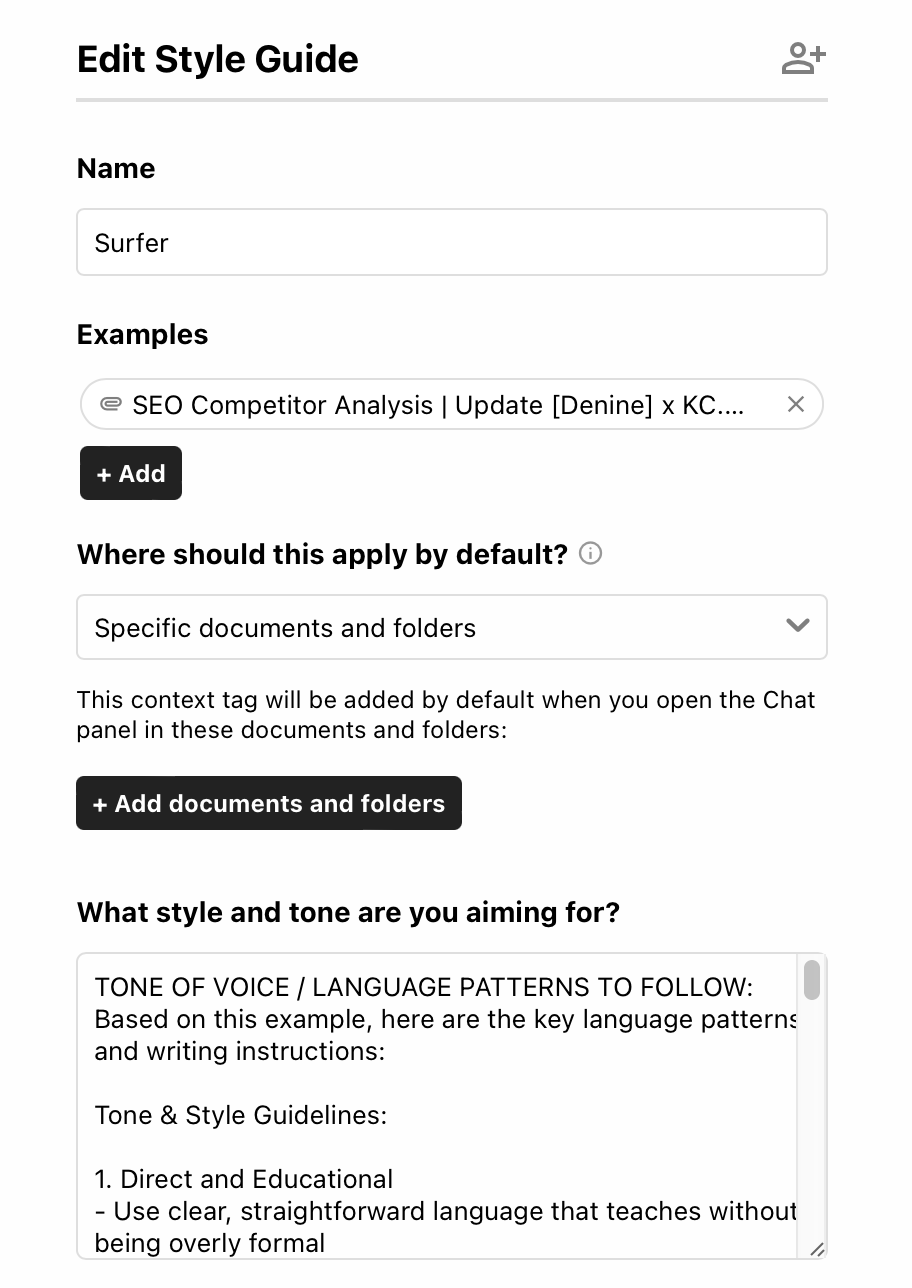
Lex hits that sweet spot—minimal, smart, and fast. It’s the one I open when I want the writing to feel easy again.
Pricing
Free plan available (with limited AI checks and functionality). Pro starts at $24.99/month and unlocks premium models, new tools, unlimited checks, and early-access features.
6. Notion
I used to treat Notion like a digital junk drawer with calendars, invoices, and half-finished outlines.
Then the 3.0 update dropped, and suddenly it wasn’t just a note-taking app anymore.
Now, it’s a full-on AI workspace that researches, summarizes, and even learns how you write.
Why I love it
Notion’s AI doesn’t just write for you—it works with you inside your workspace.
It pulls context from your pages, Slack, and Google Drive, so with every draft, it already knows what you’re doing.
The magic’s in these details:
- Connected apps for instant context.
- Custom Instructions that update as you give feedback.
- Model switching between GPT-5, Claude, and Gemini.
When I start a new brief, I switch to Research Mode.
It pulls info from my workspace and the web to build a detailed summary, like this one for AI tools for SEO: “Summarize key insights from @SEO Resources and @Content Strategy notes, plus recent web trends.”

Seconds later, I have a structured report combining my own notes with live SERP data—something that used to take me an hour (or much more).
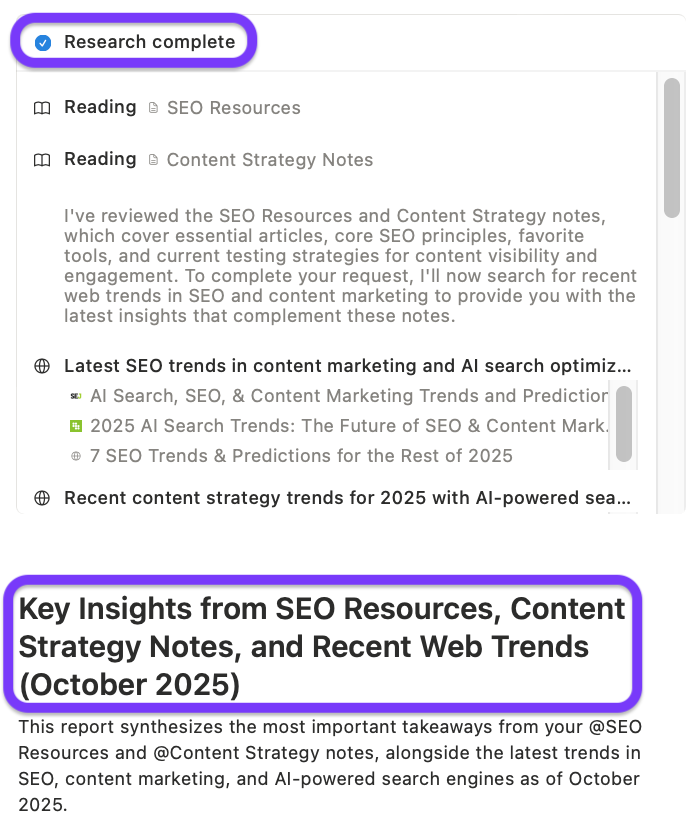
Once I’ve got a draft, I use Ask AI to refine it.
I’ll highlight a paragraph, click Ask AI, and type something like: “Add an example.”

It’s not as direct as ChatGPT’s Canvas, but it’s surprisingly smooth.
I also keep a Custom Instructions page that doubles as my tone guide—who I am, my voice, and how I like edits phrased.

To use it, I highlight text, choose Ask AI, reference the page with the @ symbol, and type: “Style Rewrite this intro using my @SEO Writing Style Guide and Custom Instructions.”
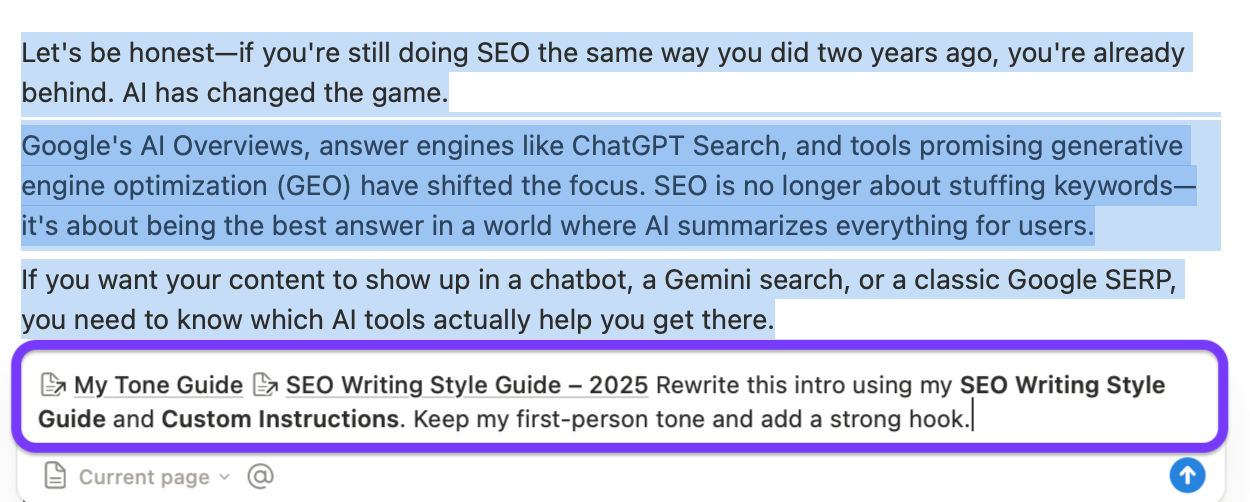
Here’s the best part: Notion actually learns. If I tell it, “Make this sound more confident—and remember that next time,” it updates my tone guide automatically.

When I find a good workflow or prompt, I star it.
My favorite? “Add an example.” No more typing the same thing every time.

Honestly, Notion’s AI isn’t a replacement for my writing tools—it’s the glue that keeps everything talking to each other.
Pricing
Notion AI is included with Business ($24/user/month) and Enterprise plans, but free and Pro users get limited trial responses.
7. Jasper
Jasper is one of the earliest AI writing content assistants, becoming immensely popular before ChatGPT.
They recently underwent a major branding and product revamp, so I had to check them out myself.
Why I love it
The fact that Jasper houses its workflow on a single screen is a winner, in my opinion. It’s a small detail but I find that it streamlines my writing process if I’m not clicking through multiple screens.
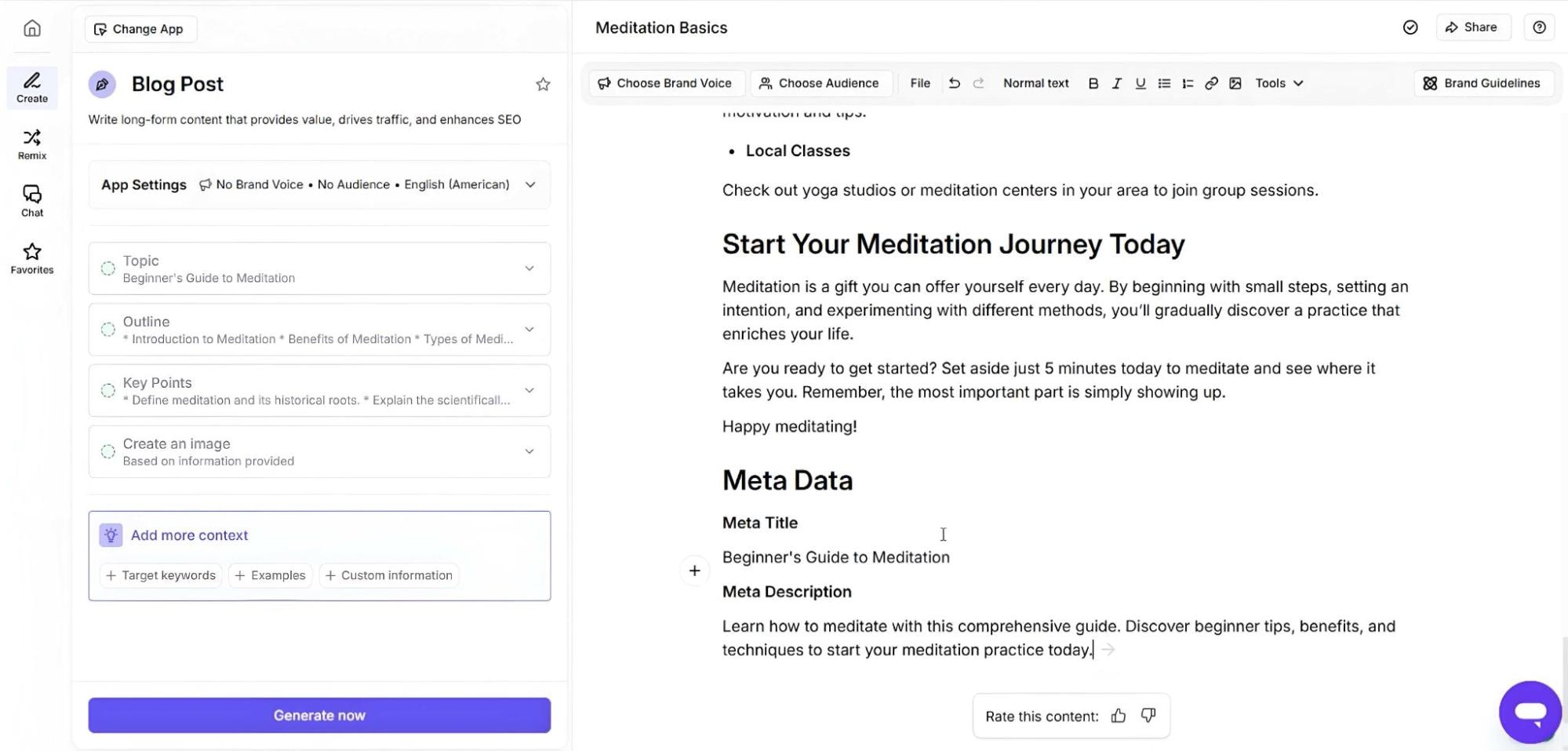
Jasper offers pre designed templates for different content — blog posts, outlines, social media captions, and product descriptions and so on.
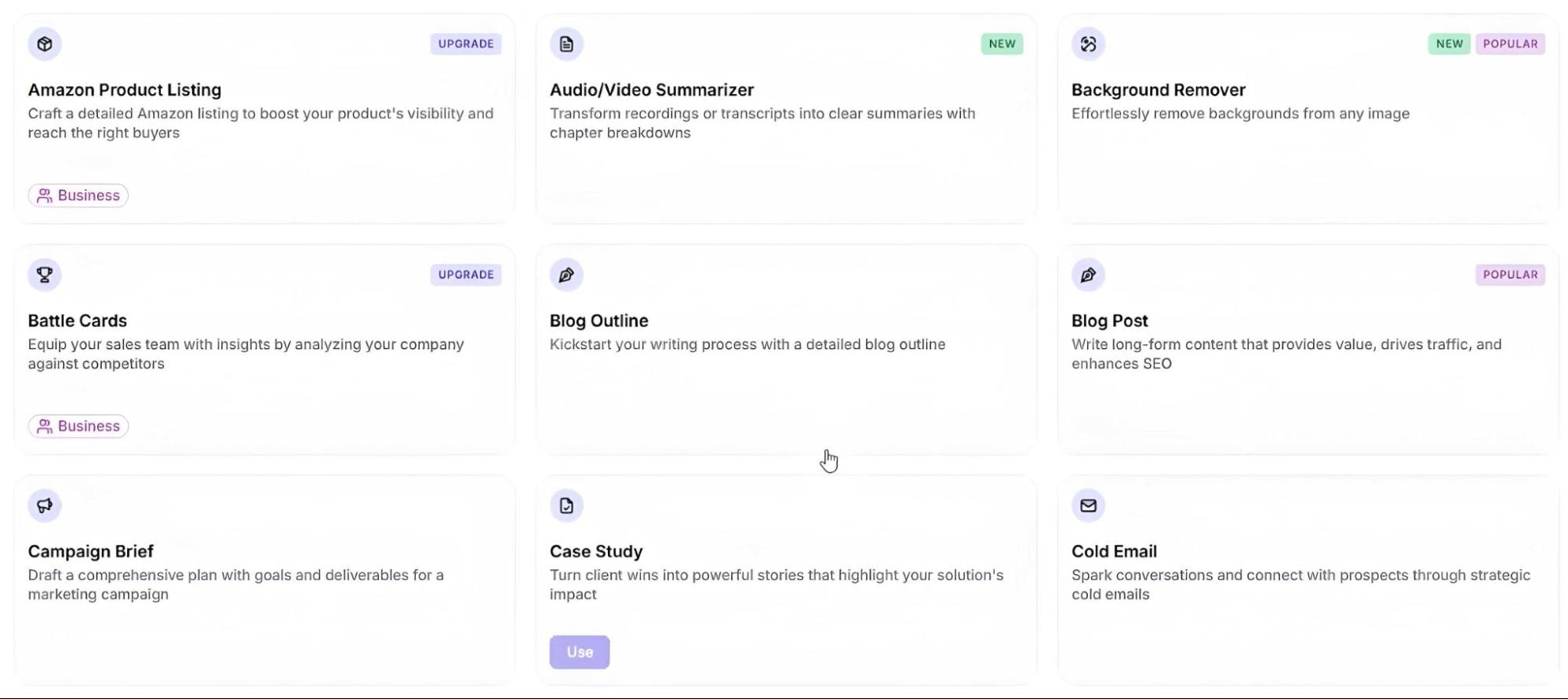
Like with Google’s Notebook LM, you can upload source materials to give the tool context and references to draw from.
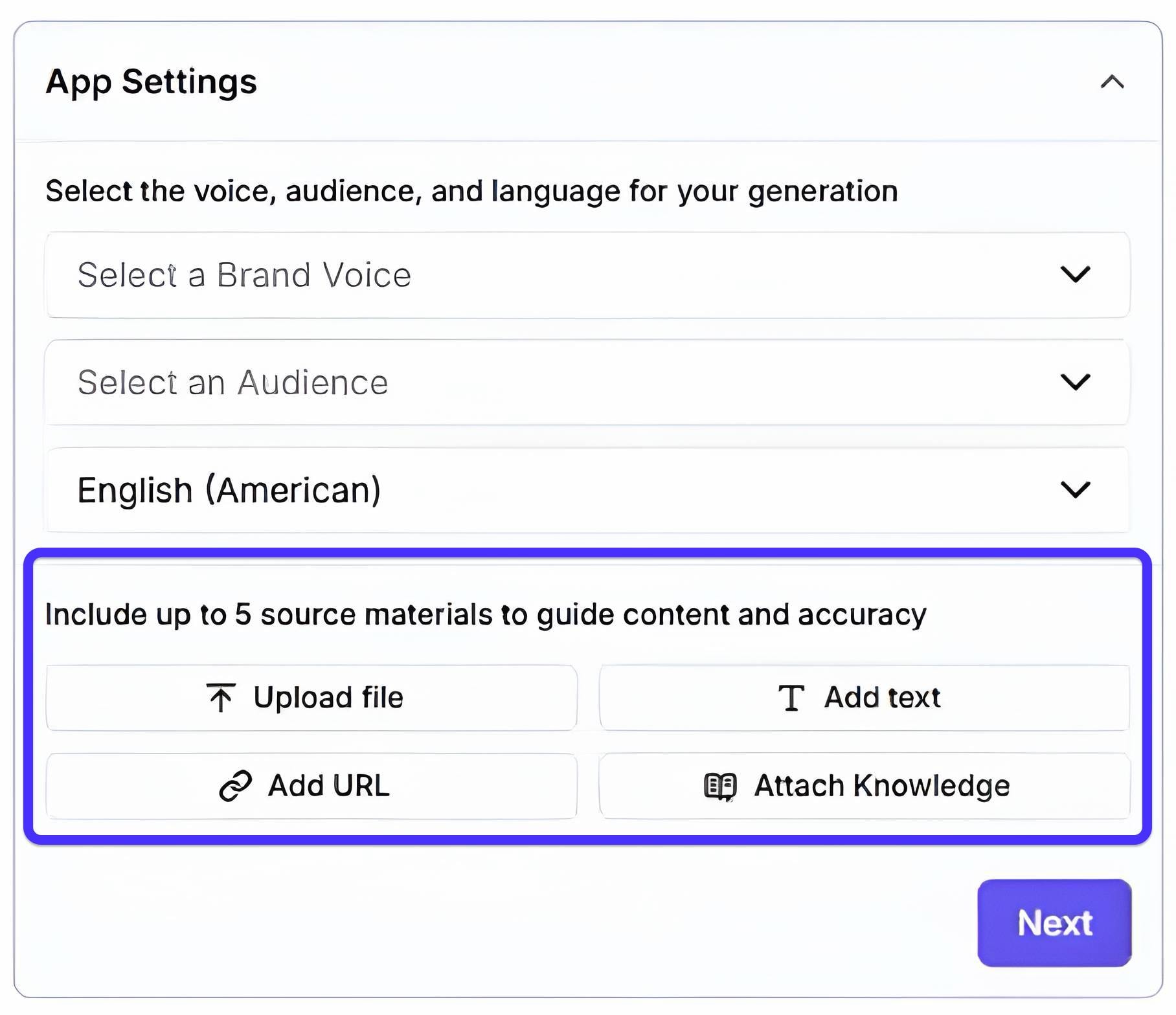
What I find most useful about Jasper is how you can add context, adjust tone, or refine sections individually rather than regenerate entire drafts. It’s not perfect and still requires editing and fact-checking, like with other AI writers but does a great job of getting you half way there.
Jasper also has a handy Chrome extension so you dont always have to work in-app. I like the fact that unlike most extensions that serve as a way to get you into the app, Jasper’s extension functionality gives you access to most writing features in the product.
Pricing
Jasper is priced at a premium and offers only 2 plans. The Pro plan starts at $59/month with a 7-day free trial, while the Business plan has custom pricing.
Still not sure which AI writing tool to choose?
My advice: Pick the one that seems best for you, try the free version (if available), and see if it fits your workflow and actually helps you create high-quality content. If it does, upgrade to the paid plan. If it doesn’t, try another.
Here’s my advice on the best tool to try depending on your situation and goals:
- If you’re new to AI content writing tools, start with ChatGPT or Claude. They’re intuitive, flexible, and show how AI can support your writing instead of replacing it.
- If you live in Google Docs or Gmail already, try Gemini. It plugs right in so you can bounce ideas without breaking your flow.
- If ranking in search engines and AI search results is important to you, go for Surfer. This is what it’s built for.
- If you need to systemise your content operations with a large team, go for Jasper. It’s built for scaling but takes a little more learning.
- If you just want a clean AI content writing tool (and don’t care for SEO), Lex and Notion are your best friends.
Remember, AI content tools shouldn’t make the job less fun, more stressful or more time-consuming. If that happens, try a different tool.





